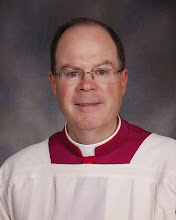Our young adults had a
barbecue last night. They fed me one hamburger, one hot dog, and one
homily. Today’s homily.
Before I’d even reached for
the mustard, a young parishioner asked me whether most Catholics believe in the
Real Presence. I answered that I don’t know, but that I am fairly sure many
Catholics do not understand the Real
Presence.
Opinion polls, which are
extremely helpful to the Church, can’t answer the question—because to ask
people whether they believe in the Real Presence, we’d have to define it. And
that’s something you can’t do on a survey.
But it is something you can do in a homily. So let’s just take a survey
sample of one, and ask ourselves “Do I believe in the Real Presence?” But before you answer “yes, no, or maybe”
let me try to do what a survey can’t, by explaining something of what the Church
teaches about the Body and Blood of Christ.
Of course when we talk about
the Real Presence or the Body and Blood of Christ we’re talking about the Mass.
You can’t separate today’s feast from Holy Thursday. And when we’re talking
about the Mass, we’re talking about the saving sacrifice of Jesus. You can’t
separate Holy Thursday from Good Friday. And we sure can’t separate anything we
believe from Easter Sunday.
Already you can see that no
ordinary survey can accurately determine whether or what Catholics believe.
Today’s feast presumes all
that we believe about the Mass, but it focuses on one aspect. That aspect was
defined with theological precision at the Council of Tent, in 1551. It taught that
“In the most blessed sacrament of the Eucharist ‘the body and blood, together
with the soul and divinity, of our Lord Jesus Christ and, therefore, the
whole Christ is truly, really, and substantially contained.’”
That’s a real mouthful of
theology. What St. Paul writes in our second reading is plainer: Jesus said “this
is my Body” and told us to eat and drink in remembrance of him. From the
beginning, the Church has taken Jesus at his word.
And why not? It seems obvious
why Jesus should want to remain present to his Church in this unique way. The
Catechism of the Catholic Church says “Since Christ was about to take his
departure from his own in his visible form, he wanted to give us his
sacramental presence; since he was about to offer himself on the cross to save
us, he wanted us to have the memorial of the love with which he loved us ‘to
the end,’ even to the giving of his life” (CCC 1380).
St. Paul VI explained that this
presence is called ‘real’ not because the other types of Christ’s presence are
not ‘real’ too, “but because it is presence in the fullest sense: that is to
say, it is a substantial presence by which Christ, God and
man, makes himself wholly and entirely present” (Mysterium Fidei, 39).
Although we speak of the Real
Presence, we know that Jesus is really present in many other ways: in his
word, in his Church’s prayer, where two or three are gathered in his name, in
the poor, the sick, and the imprisoned, in the other sacraments and their
ministers, and in the sacrifice of the Mass. But he is present most especially in his Body and Blood (CCC 1373).
A very simple example: Jesus
was truly present at last night’s barbecue, where the young adults were
gathered in his name. It was an event of small-c communion. But I got an email
from one of them written at two in the morning—because after the party he’d
gone to spend time with Jesus in the adoration chapel at Holy Trinity. Because Jesus
was present there in a special way, a way so special it was worth a very late
night.
Today’s Gospel might remind
us more of the barbecue than Eucharistic adoration. But it’s a miracle of power
that should turn our thoughts more to heavenly than earthly food. Jesus shows
not only that he’s powerful but generous. I wonder if the struggle to believe
in his Real Presence is because we’re not sure he’s powerful enough or generous
enough to perform the miracle of all miracles, transforming ordinary food into
the Bread of Angels, the healing of wounded hearts, the source of holiness, and
the cause of unity.
So let’s take the survey. Do
I believe that Jesus is present in that tabernacle, and will be present soon on
this altar, Body, Blood, Soul and Divinity?” Putting it another way, do I take
Jesus, who said “this is my Body” and “this is my Blood,” at his word?
Some of us will answer with a
firm yes. Some, perhaps, with a firm no. But many of us will answer with the
famous words of the father whose Son Jesus had just healed: “I believe; help my
unbelief” (Mk. 9:24).
What do we do to strengthen
our faith in the Eucharistic presence? Pope Francis answered this question in
one of his daily homilies. He called prayer, adoration, and acknowledging that
we are sinners the three paths which help a Christian know and understand the
mystery of God. Then he added something rather bold: “one cannot know the Lord without
[the] habit of adoring, of adoring in silence” (Homily, October 20, 2016).
He called us to rediscover
“the silence of Adoration.”
Whatever answer you gave to
the personal survey, that sounds like good advice. There is, as I mentioned, an
adoration chapel nearby at Holy Trinity. And we hope to schedule more adoration
of the Blessed Sacrament here at Christ the Redeemer, starting in the Fall. But
every day the Lord waits for you in the church, which is open daily from about
7 to 5, and very often until 9.
Take Jesus at his word, and
meet him in his Real Presence.



No comments:
Post a Comment